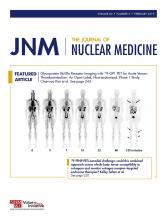We thank Dr. Lu and Dr. Sweiss for their comments on the “Joint SNMMI–ASNC Expert Consensus Document on the Role of 18F-FDG PET/CT in Cardiac Sarcoid Detection and Therapy Monitoring” (1). In their letter to the editor (2), the authors describe a 72-h high-fat, high-protein, very low-carbohydrate (HFHPVLC) diet (3) for patient preparation before 18F-FDG PET/CT for cardiac sarcoidosis and recommend that others verify what they consider to be a simple and straightforward protocol. They cite their experience and publication that included 12 scans with a 24-h or less HFHPVLC dietary preparation and 193 scans with a 72-h HFHPVLC diet before the 18F-FDG PET/CT. They reported a 41.7% (5/12) rate of failed myocardial suppression with the shorter HFHPVLC dietary preparation, and only a 3.6% (7/193) rate of failed suppression with the 72-h dietary preparation.
Although we appreciate Dr. Lu’s and Dr. Sweiss’ suggestion that long-term prospective multicenter clinical trials are required to further validate the optimal patient preparation for 18F-FDG PET for cardiac sarcoidosis (CS), we respectfully disagree that their study provides sufficient data to recommend a 72-h HFHPVLC diet. The biggest issue with their study is that the comparison group included only 12 patients and that specific details on dietary preparation for these patients are uncertain. Such details are important, since in contrast to the study by Dr. Lu and colleagues, other previously published studies using the shorter high-fat, low-carbohydrate diets with or without prolonged fasting reported a substantially higher rate of successful myocardial suppression in the range of 87% to 93% (4). The only other previously published study to use a 2-d high-fat, low-carbohydrate diet with a 12- to 14-h fast reported a myocardial suppression rate of 76%, in contrast to the 96.4% reported by Lu and colleagues for their 72-h dietary preparation. In our experience, compliance with the preparation recommended by the joint Society of Nuclear Medicine and Molecular Imaging (SNMMI)–American Society of Nuclear Cardiology (ASNC) expert consensus document (1) is realistic, practical, and achievable and yields an approximate 90% success rate.
We would also like to point out that the diet recommend by Lu et al. is not “simple and straightforward.” In our own experience, and that of others, there is a high rate of noncompliance with more prolonged high-fat, low-carbohydrate (HFLC) dietary preparations, and many patients report an aversion to consuming HFLC meals for even 24 h. In our practice, we also noted a high rate of noncompliance with dietary preparations that required a special breakfast, since patients often travel long distances to undergo their 18F-FDG PET/CT study at our institutions and present directly to their PET study. They indicated challenges in having to stop for a special meal at a specific time in the morning.
Regarding the interpretation of cardiac PET images, Dr. Lu and Dr. Sweiss point out that a concurrent rest myocardial perfusion study can somewhat increase the diagnostic certainty of CS but also that with optimal suppression of physiologic myocardial 18F-FDG uptake, the rest myocardial perfusion study or reorientation/reconstruction of cardiac 18F-FDG PET/CT images might not be needed. Again, we respectfully disagree with these points. First, the combination of the resting myocardial perfusion and 18F-FDG images provides important information regarding the likelihood of CS, and can provide more specificity with regards to the pattern of disease that a patient may have (e.g., degree of active inflammation vs. possible scar) (4,5). Second, isolated lateral wall 18F-FDG uptake without perfusion abnormalities is likely a nonspecific finding, whereas lateral wall 18F-FDG uptake with a perfusion abnormality is consistent with CS in the appropriate clinical setting. Therefore, the perfusion image can be very helpful in adjudicating isolated lateral wall 18F-FDG uptake. Third, treated CS may demonstrate improvements in both perfusion and 18F-FDG abnormalities. Fourth, the combination of myocardial perfusion and 18F-FDG images help to define the prognostic spectrum of CS, with the combination of abnormal myocardial perfusion and abnormal 18F-FDG uptake conferring a 4-fold increase in the annual rate of ventricular tachycardia or death compared with normal imaging results (6). Lastly, the reconstruction and reorientation of both sets of images are necessary to display perfusion and 18F-FDG images simultaneously and integrate their interpretation. Another benefit to the traditional nuclear cardiology display is the ability to assess the gated PET or SPECT myocardial perfusion images for left ventricular volume, wall motion, and systolic function. Therefore, our recommendation is to acquire, reconstruct, and reorient and interpret both sets of images using the traditional nuclear cardiology display, in addition to viewing the images on the hybrid PET/CT display.
In summary, we appreciate the interest in our Joint SNMMI–ASNC expert consensus document but stand by its conclusions. We all agree that large prospective studies may further inform the optimal patient preparation and interpretation for 18F-FDG PET for CS.
- © 2019 by the Society of Nuclear Medicine and Molecular Imaging.







